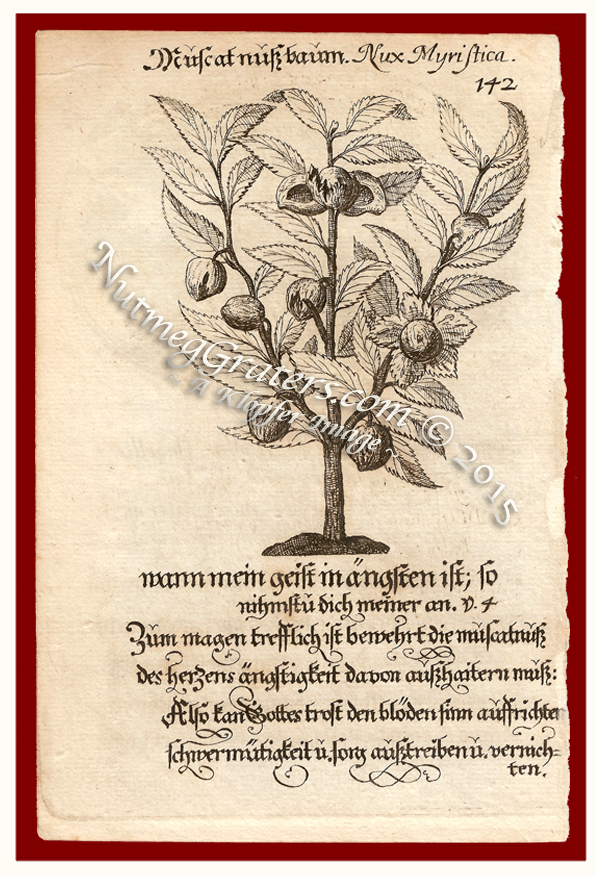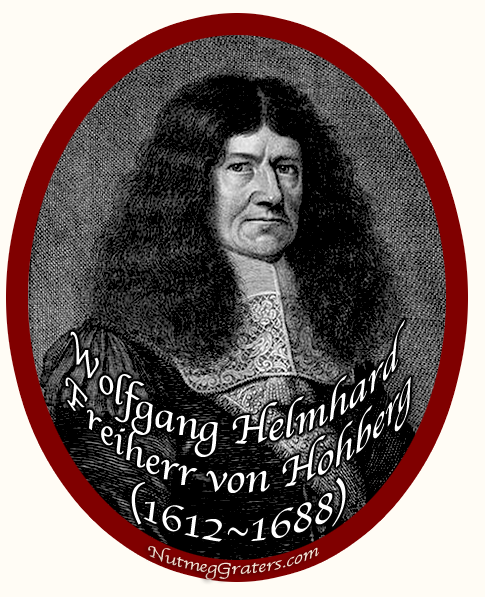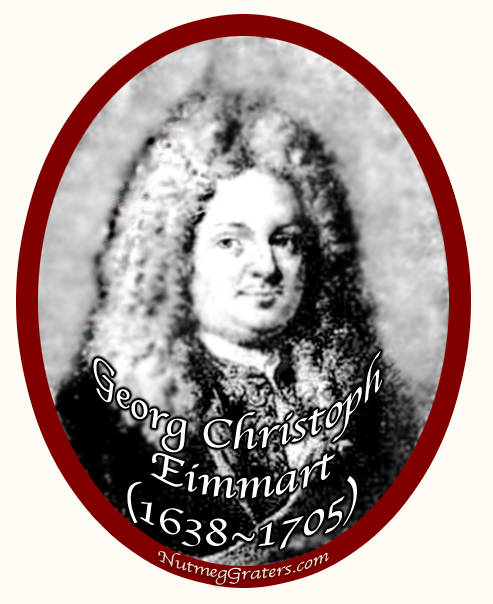NutmegGraters.Com

 "Muscatnukbaum, Nux Myristica" ~ 1675 ~ Wolfgang Helmhard Freiherr von Hohberg ~ Lust und Artzney-Garten des Köeniglichen Propheten Davids
"Muscatnukbaum, Nux Myristica" ~ 1675 ~ Wolfgang Helmhard Freiherr von Hohberg ~ Lust und Artzney-Garten des Köeniglichen Propheten Davids
PRINT ENTITLED: "Muscatnukbaum. Nux Myristica".
SOURCE: Lust- und Artzney-Garten des Köeniglichen Propheten Davids.
AUTHOR: Wolfgang Helmhard Freiherr von Hohberg, (and Additional Work by):
Johann Ernst Gerhard, Hieronymus Gradenthaler, Johann Ludwig Prasch.
ILLUSTRATOR/ENGRAVER:
Georg Christoph Eimmart (Jr.)
MUSIC: Jerome Kradenthaller, Hieronymus Degree Thaler.
EDITOR: Regenspurg: Frey Singer & Emmrich.
PRINTED BY: Christoff Fishermen in laying Georg Frey Sigmunde Singers of the elder
and John Conrad,
BOOKSELLER: Emmrichs Beeder, burgers and booksellers dasselbst.
DATE OF PUBLICATION: 1675.
SCOPE AND PURPOSE OF PUBLICATION: A spiritual volume containing rhymed palms
paraphrases; with special Melodey basso continuo; engravings of lovely flowers or
plants to include description of their usefulness, and morning & evening prayers.
PRINT METHOD: Copperplate engraving; a plate mark identifying the intaglio process.
PAPER TYPE: Handmade antique laid and chain ~ link paper, bearing no water mark.
COLORING: None.

 HISTORY: Lust- und Artzney-Garten des Köeniglichen Propheten Davids is described as one of the most beautiful books of the seventeenth century. A 526 page publication, the text contains 300 copperplate engravings, many being plant images. The illustrated engravings are printed on both sides of a page. It is written in the form of Emblem (Kunsthistorische Kategorie) [ ἔμβλημα ~ in Latin] where as an art form, images and text are combined in a creative way using three parts: the Lemma (a motto or verse at the top), the Icon (which is the visual engraved image), and the Epigram (a written puzzle to connect the Lemma and Icon to make the reader solve a deeper meaning). Within this book, the Lemma on the "Recto" (or face or front of a page) are written in Latin and German verse; the "Verso" (back of a page) uses illustrations of plants and is written only in German. Translating page 142, which is a "Verso" page, "Muscatnukbaum, Nux Myristica" seems straight-forward: It describes that the nutmeg from the nutmeg tree is God's way to aid management of the spirit, while being excellent for the stomach and beneficial to quiet the heart. Being among early illustration for nutmeg, the engraving does not accurately depict the "nutmeg tree", instead showing a contemporary image of the era.
HISTORY: Lust- und Artzney-Garten des Köeniglichen Propheten Davids is described as one of the most beautiful books of the seventeenth century. A 526 page publication, the text contains 300 copperplate engravings, many being plant images. The illustrated engravings are printed on both sides of a page. It is written in the form of Emblem (Kunsthistorische Kategorie) [ ἔμβλημα ~ in Latin] where as an art form, images and text are combined in a creative way using three parts: the Lemma (a motto or verse at the top), the Icon (which is the visual engraved image), and the Epigram (a written puzzle to connect the Lemma and Icon to make the reader solve a deeper meaning). Within this book, the Lemma on the "Recto" (or face or front of a page) are written in Latin and German verse; the "Verso" (back of a page) uses illustrations of plants and is written only in German. Translating page 142, which is a "Verso" page, "Muscatnukbaum, Nux Myristica" seems straight-forward: It describes that the nutmeg from the nutmeg tree is God's way to aid management of the spirit, while being excellent for the stomach and beneficial to quiet the heart. Being among early illustration for nutmeg, the engraving does not accurately depict the "nutmeg tree", instead showing a contemporary image of the era.
Although Wolfgang Helmhard Freiherr von Hohberg (1612~1688) is given primary credit as author, he also acted as the editor by including well known works from other authors and artists of the period. Georg Christoph Eimmart (Jr.) (1638-1705) is credited as the engraver. The majority of the music is by Hieronymus Degree Thaler. The paraphrase of the Psalms is by Johann L. Prasch.
[KLOPFER article © September 2015]